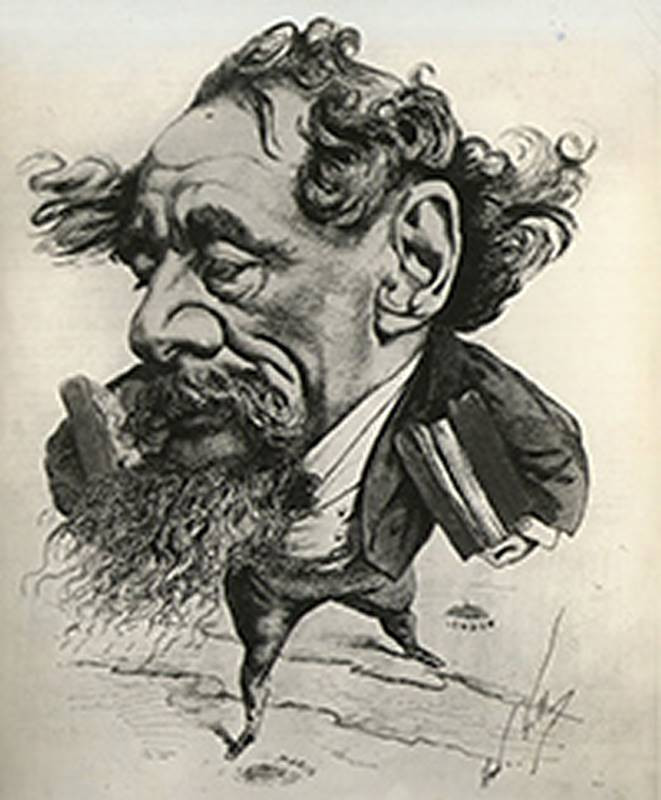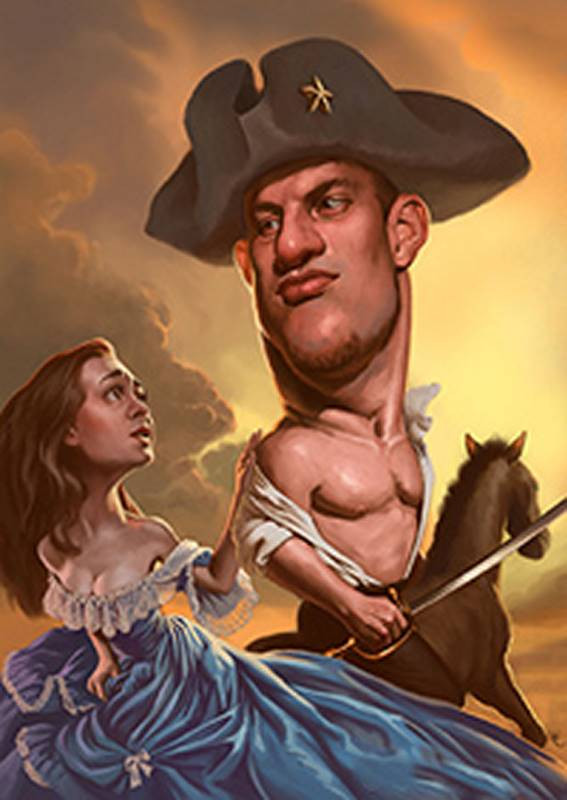Now that we’re all experts at caricaturing the human face, we can’t forget about the rest of the body. Oftentimes, an inexperienced caricaturist will spend all of their efforts exaggerating the face and just throw on a neck and a small body as an afterthought.
When you’re working as an illustrator or doing commissioned caricature portraits, the reality is that you’ll almost always have to include some or all of the body. And just like with the head, the body’s proportions can be changed for humorous reasons, to help you better recognize the subject, or most commonly, to help tell a story or point of view about the subject.

There are two basic factors that should help guide you in caricaturing the human body: The first is the overall body type of your subject, and the second is its pose, or action.
When figuring out the body type, just like with the face, you should judge your subject’s body against the average, and make those differences more obvious in your sketch. A tall skinny person becomes more tall and skinny. A bulky muscular person becomes even more muscular. And so on.

The second main factor that will help you decide how to caricature the figure is the action of the pose. How people carry themselves when standing, moving or sitting can sometimes tell you a lot about their personality. Or you may want to highlight or insert particular character traits in your drawing, so you would [change the pose] to suit your own opinion about the subject.
Drawing the Body
The Gesture
Just like we did with the face, start the body with a loose thumbnail sketch. And the first thing you should get on the paper is the [overall gesture], or movement, of the pose, from head to toe. So your first step will be a simple circle for the head and a line. This will be the primary motion of the pose. If you worry about anatomy or proportions too soon, you’re more likely to end up with a stiff pose.
Whatever the pose is, try to heighten the drama of it. Even if the person is just standing still, try to inject movement or a distinctive posture. If the figure is in motion, try to think like an animator doing a key frame showing the action at its peak, or most extreme. Remember, you are exaggerating the action of the pose in this first step. And later, when you flesh out the sketch, you will exaggerate the proportions.
Head Size
Caricatures traditionally have oversized heads. They don’t have to. But, aside from being instantly funny, an oversized head helps make the expression and likeness easier to see when it’s shrunk down for print. Throughout history, caricatures have traditionally been reproduced very small in newspapers and magazines. The oversized head was more of a practical decision for easier readability. It’s my belief this is why the big-head tradition is so deeply rooted in the art of caricature. But a small head on a large body can be equally funny, when it’s appropriate for the subject. Whatever the head size you choose, it’s important that the head blends seamlessly into the body. So you’ll still want to be careful how you show the connection between head, neck and body. The head should never looked like it’s just enlarged and pasted on.

Example #1: Long thin body type
Beginning with the gesture of the pose, show the main action by drawing a line from head to toe. You can draw a simple stick figure when adding the arms and legs or create a simple cylindrical mannequin. The important thing is to just be sure it is built on a dynamic and interesting skeleton. When you're satisfied with the gesture, you can then build the anatomy around it. This course won't cover the anatomy of the figure or clothing and drapery. That's a whole other course. In the premium section of this course, you can watch me draw this and other caricature body sketches in more detail.

Example #2: Muscular body type
When you caricature a muscular person and you want to exaggerate their brawny physique, you will need to be somewhat familiar with realistic anatomy. If you’ve never studied [artistic anatomy], you could just try to fake it and just work from your photo reference. But you will most likely only reveal your lack of knowledge by exaggerating muscles in the wrong ways. Understanding the forms and functions of the muscles will give your caricature work extra credibility and give you more options when you exaggerate your subjects.
And remember, not every muscular person has the same type of bulk. Some muscular people are very lean, while others are very thick and bulky. And how you draw their posture and movement will help convey their personality.

For a muscular person, such as Dave Bautista, drawing a head that is disproportionately small usually works better than an overly large head. That way, the muscular physique becomes even more extreme. Again, for a more detailed look at this and other body drawings, check out the premium version of this course.

What's Next
The next video will be a review of the first six lessons on the fundamentals of caricature. Don't worry, this was not the last caricature lesson -- not by a long shot. There's a lot more material in the upcoming episodes, which will cover more advanced concepts in caricature.
To see lots more examples of caricaturing different body types, check out the [premium course]. In the premium course, I show how to caricature: children, heavyset people, voluptuous women, doughy middle-aged men, elderly people, Prokopenko people. We don’t spare anyone’s feelings!
Assignment
Find or take photos of some extreme body types. They lend themselves better to caricature. And bodies in good action poses are even better still. Practice your caricature bodies by starting with the gesture of the pose, and then build your anatomy around it. Also figure out how big or small the head should be in relation to the body.












